
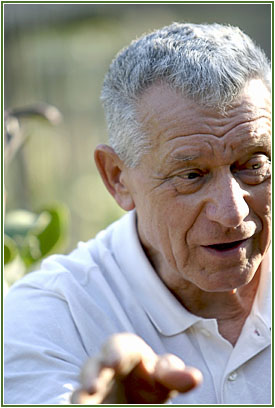 |
|
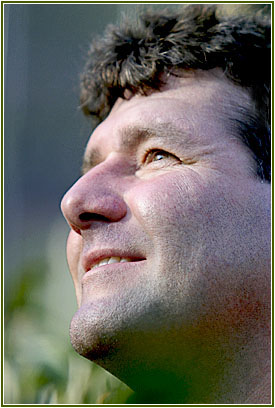 |
Wladyslaw Zaslawski was born in Poland but Brazil is the country
of his adoption. Orchidist since de decade of 50, he decided
to found, in 1994, with his son, Aleksandro Zaslawski, the nursery
AWZ Orchids, in the state of Espírito Santo, with greenhouses
in two different climates. One in Viana, at 300m altitude for
cultivating plants which need warm conditions and the other one
Pedra Azul, at 1.100m altitude. Wladyslaw and Aleksandro, more
orchid lovers than tradesmen, dedicate almost their whole time,
to maintain their own collection and the commercial nursery. Great
experts in Brazilian habitats, they talk us about their journeys
to visit orchids in the nature.
ON: Wladyslaw,
when and how have you started to cultivate orchids?
WZ: My parents and I had just come to Brazil
and we used to live in a small place called Santa Lúcia, in Vitória,
Espírito Santo. By this time, there was much more "green"
than nowadays and, behind our home, in the middle of the wood,
there was a rock was a blooming plant. Later I learnt it was a
Cattleya guttata. I have never seen it in my whole life,
where can we find it in Europe? Nowhere. This called my attention,
I got this plant, I cultivated it, then I got another, then another
and so on. This plant that I discovered blooming in March 1953
is still here, in Viana, alive and healthy.
ON: Although you speak Portuguese without accent, you are Polish.
WZ: I am Brazilian but I was born in Poland
and come here without speaking a word in Portuguese.
ON: So you have 52 years of cultivation. You started your commercial
nursery by this time?
WZ: No, I worked as an engineer at the "Companhia
Vale do Rio Doce" where I stayed for 33 years and I have
also been a teacher at the Federal University for 25 years. I
retired in 1991, with an excellent expertise in railways engineering
and, thus, I was asked to be adviser in this field of action.
Alek, my son, he also is a mechanics engineer and I found a company
to work in this domain. For 4 or 5 years, we worked as railways
advisers through Brazil for the big companies. When the Railways
Network and the Companhia Vale do Rio Doce became private, they
got out from a bad situation but they didn't come to nothing better
in the free enterprise. The Railways Network has been separated
and the regions have been sold, the companies which bought all
of this have just interest in to make use of their own branches,
they make efforts to improve the transports according to their
own needs. Those railways didn't have much interest in development.
Do you know Esopo' s fable, when the animals join themselves to
the cart and decided to pull it? There were a donkey, a swan e
a fish. When they were about to go out, the swan wanted to fly,
the donkey want to eat the grass and the fish saw the water and
wanted to jump and the cart didn't move. In my point of view,
there was nothing in terms of improving the national railways
network, nothing happened. Thus we couldn't go on giving advisers
and we decide to close the doors.
ON: So you decided to open the commercial nursery?
WZ: In 1994, 95, as Alek also likes orchids
very much, I asked him to be my partner. All along those 50 years
of cultivation, I had gathered an extensive collection of native
orchids, not only Brazilian but also from another countries. I
always looked for standing out by the qualities of the plants
concerning forms and colors among another characteristics. I had
good species, good varieties but not only this. My collection
had at about 20.000 plants coming from around the world. But,
before this, in 1991, due to the difficulties to obtain species
because they are rare or because the habitats gradually disappear
or also because some of them were foreigner and difficult to get
here, we decided
to reproducing many species from the collection in
our own laboratory.
AZ: Our aim is to supply orchids species of high lineage since
the matrixes are plants selected along all those years. Our whole
production is made in our unique and specific laboratory for this
aim in the state of Espírito Santo. It is outfitted with
all modern and necessary equipments which allowed us to reach
the productions of healthy and vigorous plants with exportation
standard.
ON: Even before having your commercial nursery, you had your
own laboratory?
WZ: Yes, I loved this research, I liked
to develop but Alek and I have improved the laboratory. It started
in Pedra Azul, we did it together but, in fact, all this is much
more Alek's work than mine
ON: And you, Alek, how did you get involved with orchids?
AZ: I always loved to go along with my father to the habitats
and since I was a kid I have been strolling across the greenhouse.
ZW: He always comes with me, and, by the
way, not only with orchids, he is an excellent railways engineer,
we gave advisement in the same level of the people coming from
USA, Canada. And people have learnt many things with us. So when
we did this turn, we haven't much trouble. He is loving doing
this.
ON: You look so passionately fond of orchids as your father.
AZ: I always loved to keep him company mainly in the excursions,
I found it cool, I always loved the nature, I've never thought
about dealing with orchids in the level. It was for fun, it was
my father's hobby which I followed during the trips. But there
was the engineering I studies, I graduated and started to work
in mechanics engineering and suddenly, there was this turn and
we started to deal with orchids almost 100% of our time.
ON: Your catalog is mainly composed by species?
WZ: 99% of species, we preserved them in
spite of saying that it is a very little portion in the whole
but we have our ideology and we only like species. Every one has
hybrids: Europe, Japan, Brazil. The species are getting lost,
disappearing one by one. We have a good collection of Cattleya
amethystoglossa, tenuis, schofieldiana, elongata, eldorado, violacea,
and do so.
|
Besides
those from another countries such as Cattleya trianaei.
For example, we are preserving Encyclia, a plant
which is not commercial. It is beautiful, we like and, if
we can not trade it, ok, let it peaceful. It is living well
here, embellishing, pleasing. We are orchidists, we are
not only commercial. If there is not this way of loving,
there is no progress. |
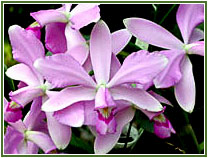
C
violacea |
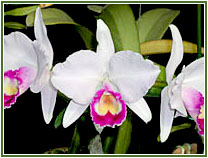 C.
trianaei
C.
trianaei |
ON: And the production of the plants?
AZ: Concerning the production of species, nowadays, we are diversifying
however Cattleyas and Laelias are still our main topic. From every
sowing, we keep at about 50/100 seedlings, we don't sell everything
to make our reserve in order to see the results, how they bloom,
it is useless to sell everything and don't see the results and
matrixes can be choose among them. Our collection is big because
don't want only wonderful plants, we don't keep only better plants.
We also keep plants with a historical value, gift from someone
so the collection increases. Some people want just the top plants
but we keep also many historical plants. We keep all this but
there is a cost and a lot of work to maintain it.
ON: Without expecting a compensation. You both have a strong
collector side.
AZ: Yes, we have. For instance, there is plants that we can, eventually,
sell or exchange but, if we have only one, we will never sell
it. No matter how much is offered, we won't sell unless we need
to divide it. We maintain all this, it is holy to us, it is the
collection. The cost is high because we don't get rid of plants.
We go slower than if we have only commercial purposes but, at
least, we do a solid work. There are people that find plant and
sell, export and no one see it again, it is over. We don't. Everything
is preserved, even, for example, the old hybrids from Floralia,
we have almost everything. We have Rolf Altenburg's meristems
that, may be, even Floralia haven't any more.
WZ: We have a pink Bc Pastoral got
from Rolf.
AZ: There are many thing done para Manarini which are anymore
available, have evaporated from the collection, Over. For example,
Epidendrum pseudoepidendrum we have is a Manarini's meristem.
ON:
And you have a rare Laelia praestans alba?
WZ: The matrix is an unique plant
bought longtime ago, I did the polenization and we have
the first blooming. Never analyze a plant by his first
blooming, you should wait the second or the third. This
species only exists in a specific region, Santa Leopoldina.
AW: This species takes all year along blooming, there
always is a blooming plant. |
|
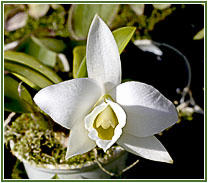
Laelia
praestans alba
(photo:Sergio Araujo) |
ON: And the Cattleya guttata which started all that
passion, is it still alive?
AZ: Yes but before buying this location in Viana, we should bring
it to Pedra Azul (cooler place) and it suffered a little. Now
it is recovering and next year it should bloom again.
ON: You have two places to cultivate with different climates.
It means that you have plants for orchidists living in warm
as well in cooler climate.
WZ: We have two nurseries, the first one
is place at 1.100 m altitude, in Pedra Azul. It cold in winter,
in general, the temperature stays at 6, 8ºC, eventually
it can drop more. Even in the summer, at night, the temperature
stays at about 17, 18º C. As we didn't have another option, I
brought there all my plants but some of them suffered a lot. Cattleya
guttata, which is not from that region, suffered a lot. Cattleya
trianaei, Cattleya lueddemanniana, Cattleya amethystoglossa,
all of them suffered a lot. So, or we did a climate greenhouse
there or we bought a new place here, in low altitude. As the lands
are not so expensive here and the installations would be cheaper
than in Pedra Azul, Alek and I decided to buy this place in Viana,
at 300m altitude and brought back all plants for warm climate.
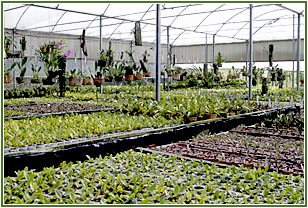
Pedra Azul
(photo:Sergio Araujo) |
|
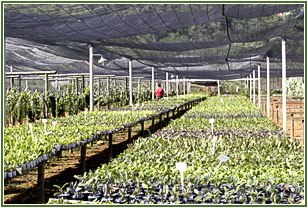
Viana (photo:Sergio
Araujo) |
ON: Cattleya trianaei and Cattleya lueddemanniana
grow better at 300m? It means that the temperature at this
altitude is really different from that at the sea level and there
is already an important drop of temperature at night ?
WZ: They grow better here. At every
100m, the temperature drops at about one degree. Besides the nursery
in Viana is surrounded by the woods, is close to the ranges of
mountains from where coming a cold air. The ideal point is when,
in the morning, there is the dew and at this altitude there is
already this point of dew.
AZ: It has a good drop of temperature at night.
ON: It is the great secret of cultivation orchids, luminosity
associated to a diary drop of temperature and also in winter...
WZ: No doubt about, this is the trio: ventilation,
luminosity and temperature. We have good aeration, so much there
was in this
region, in the past, warneri, schilleriana, at 300, 400m
altitude, on the rocks.
ON: Basically, which species do you cultivate in Viana and
in Pedra Azul?
WZ: Em Viana, Cattleya acklandiae,
amethystoglossa, schofieldiana, eldorado, guttata, nobilior,
schilleriana, trianaei, lueddemanniana, Epidendrum
pseudoepidendrum. We cultivate at em Pedra Azul where is colder,
higher, , alto, Laelia sincorana, Cattleya walkeriana
ON: Is still there many orchids in nature, around here?
WZ: No, in our region, no more.
ON: And in Pedra Azul, is possible to find anything?
WZ: There still are Bifrenaria tyranthina,
Oncidium crispum, Oncidium zappii, Oncidium colnagoi,
Scuticaria kaustsky, Sophrinitis coccinea, Sophronitella
violacea, Laelia cowani.
Near by, at Forno Grande massif, there is the Laelia macrobulbosa.
It is a rupicolous species with thick pseudobulbs and wide leaves.
The plants can reach 30cm height.
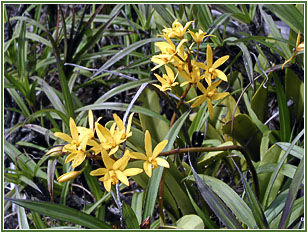 Laelia
macrobulbosa and the habitat
Laelia
macrobulbosa and the habitat
|
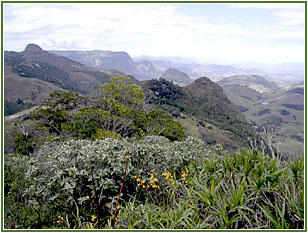 |
|
|
ON: I noticed that you keep the traditional nomenclature for
Laelia species.
AZ: We haven't changed the names, we just use the consecrated
names for the rupicolous Laelias, except for the most recently
described. Concerning the modifications which are going on, we
prefer to maintain this widespread nomenclature and wait for things
calm down and the temperature drops down.
ON: Do Cattleya velutina and Cattleya schilleriana
share the same habitat?
WZ: No, Cattleya schilleriana occurs
down bellow where there is a predominance of the maritimes wings.
The big concentration of schilleriana which occurred in the state
of Espírito Santo was in a location called Pedra dos Ventos (Crag
of Wings), at Domingos Martins region. It is a valley, or better
saying a canyon with hills at the both sides, between them the
Jucu river. It stands in the direction of Atlantic ocean.
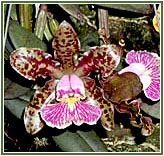
C.
schilleriana |
The
wings
predominantly maritime
go through this valley
and the evaporation of the river supplying the
plants of
humidity. Cattleya
schilleriana occurred In those flanks, growing
among the cactus, directly on the rocks, in small shrub
or on a little higher trees, everything was literally covered
of Cattleya schilleriana. En enormous quantity of
plants were collected and send to south of Brazil, to Rio
de Janeiro and São Paulo. They died because people didn't
and still don't know how to cultivate and kill that plant.
It requires a high environmental humidity, strong ventilation,
notice that its main habitat is called crag of wings were
the wing even howls. |
ON: Why? Is it that complicate?
WZ: Cattleya schilleriana that people
complain about the culture, is not very complex. You should know
how to cultivate, if you plant it in a pot, in tree fern, it will
die. If you plant it in a hard tree fern (called stone tree fern),
in a peroba bark, in any rough bark, which doesn't decompose easily,
or in a small branch of camará, in a support where the root doesn't
penetrate, which retain the humidity and lose down slowly, let
it in a lighted place, well ventilated and provide abundant water,
it will thrive very well. Camará is a shrub which grows in our
region and has a tough duramen which can last for a hundredor
two hundreds without doubt any trouble and the bark is rugged
and the schilleriana adhere very well to it.
AZ: Camará is abundant here and easy to find. You cut a branch
and it sprouts again, there is no problem. Peroba is more difficult
to find.
ON: How do you summarize Cattleya schilleriana culture?
WZ: It grows well provide we don't plant
it in pot. We should respect
the required humidity, the ventilation and strong luminosity.
It needs a lot of water however the roots should not be soaked
because it doesn't like to have wet feet. If it has appropriated
conditions, high ventilation, aerated roofs, strong luminosity
(she loves it), high humidity, it will thrive well.
ON: However, there are plants of Cattleya schilleriana
which never develop.
WZ: This is a problem of a plant which has
suffered a kind of thump, something unpleasant happened and the
plant takes a time to be recovered. I have a schilleriana coerulea
that Rolf gave to me. This is one of the plant that I should bring
to higher altitude and it suffered a thump. A year and a half,
I brought it back, it still haven't grew but one day it will react.
ON: Is the species extinct in the nature?
WZ: In Espírito Santo yes but in the state
of Bahia, a small population has been found. It is a small area
so we can say that is about to be extinct.
ON: And about Promenaea genus, which species has a good
occurrence in Espírito Santo?
AZ: There Promenaea xanthina and Promenaea stapelioides.
Promenaea stapelioides has a good variation of color.
WZ: It occurs at about 600, 800m.
ON: And about the Stenia pallida which has been
found in Bahia, what do you know about?
AZ: We have a small cutting scion but I think it is a little bit
different from that which occurs in Amazon Region. The color and
the form are similar, I didn't analyze in detail but they seem
to be different species.
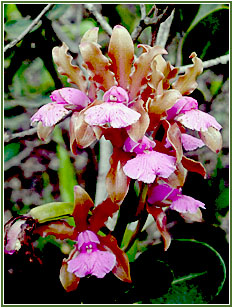 Cattleya
elongata
Cattleya
elongata |
ON:
By the way, you visited and still visit habitats in the
state of Bahia?
WZ: I liked and still like visiting
habitats but not only those in Bahia. There, we know very
well the Laelia sincorana habitat in Chapada Diamantina.
Serra do Sincorá is a beautiful place, we went there at
about eight times. We also visited Cattleya elongata
habitat which is very beautiful during the blooming season.
|
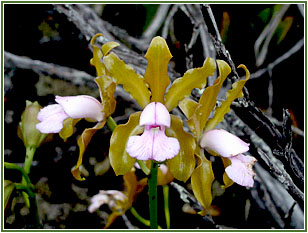 Cattleya
elongata
Cattleya
elongata |
|
|
|
|
Cattleya
elongata Habitats |
We have already gone to see the blooming of schofieldiana. We
also visited Cattleya nobilior amaliae habitat in the state
of Tocantins, a spectacular blooming, it is wonderful. We have
also visited many habitats in Espírito Santo.
AW: Once we visit more than 1.200km in a year, only inside the
state. Here, in Espírito Santo, there is a habitat of Cattleya
guttata which is amazing because of the quantity of plants
as well as the size of the habitat itself.
ON: Do you travel every year?
AZ: No, it depends, latterly with the work at the nurseries,
we have reduced those travels.
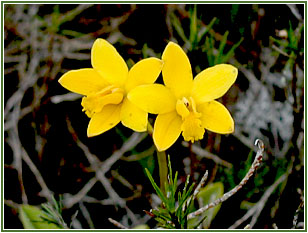
Laelia
briegeri |
ON:
To go along with your father since you were a kid, you
should be a good knowledge about orchids habitats.
AW: We did many travels together. We visited the most
beautiful habitats such Chapada de Diamantina, in Bahia,
the region of Diamantina city, in Minas Gerais. In Minas
Gerais, we traveled more than we did in Bahia.
WZ: Much more. Practically we visited
all those rupicolous habitats, they are outstanding. We
have already seen Laelia milleri, Laelia angerer,
in blossom, the most difficult such as Laelia flava
at São Tomé. The blooming of Laelia briegeri in
the habitat is something. |
ON:
Alek, what is your favorite kind of habitat?
AZ: Each habitat has its own attribute. The wood is fine
but you stay limited, it is more difficult. The blooming
is exuberant but the plants are on the top of the trees.
I prefer rupestrian places where we have a more extensive
view. In the top of mountain of rock, you have a great
view and see of the those small plants sprouting on the
rocks is wonderful. Diamantina, for instance, is a region
easy to walk, there are many plants. So, to me, those
are the most beautiful places. |
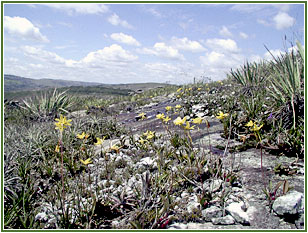 Serra
do Espinhaço-MG
Serra
do Espinhaço-MG
Laelia briegeri habitat, near to Diamantina
city
|
ON: And the new rupicolous species, have you visited their habitats?
AZ: We have already traveled all over the habitats of those new
species, Laelia kleberi, mirandae (Hoffmannseggella
mirandae), colnagoi (Hoffmannseggella colnagoi).
ZW: We have already seen all those plants
blooming in their habitat.
|
|
| (Laelia
kleberii habitat, recently discovered in the Serra do
Espinhaço. The predominant color is light yellow
but the plants have a great variation of colors. |
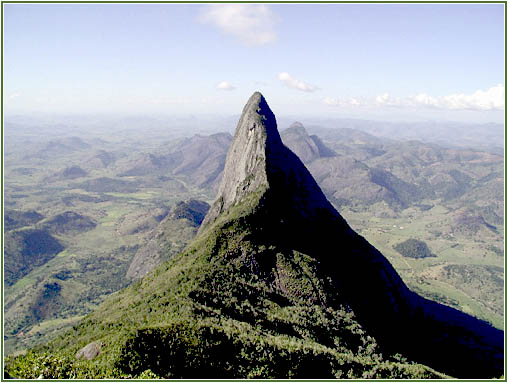
L.
colnagoi habitat |
ON:
And about the Laelia colnagoi habitat?
WZ:
The climbing is not very long but it is a slope, so requires
training and cold blood. We just can get there because of
the bromeliads serving as a support to be hold during the
climbing.
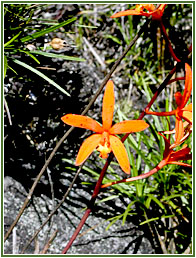
L.
colnagoi |
| AW:
We are already reproducing those plants, we have sown. Nowadays,
we are diversifying the production of the species to let
people have access. |
ON: And about Laelia mirandae (Hoffmannseggella mirandae)?
|
|
|
|
Laelia
mirandae |
Laelia
crispata |
L.
x britoi (natural hybrid -L.crispata x L.
mirandae |
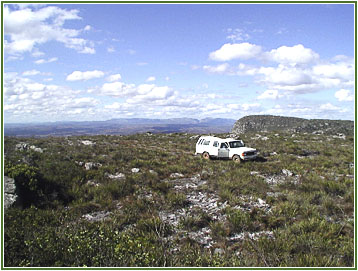 |
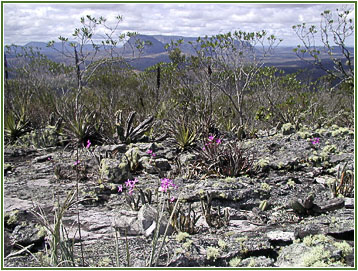 |
|
Laelia mirandae Habitat - Serra do Espinhaço
(north region). |
AZ: This species is closely related to Laelia angererii.
The region is drier and there also is the Laelia crispata
(Laelia rupestris). It is not difficult to find a natural
hybrid between both which has recently described as L x britoi.
The colors vary very much from pink to orange or red.
ON: Reproducing you are contributing for the preservation of
the species because they are about to be extinguished in their
habitats.
WZ: Laelia milleri is being extinguished,
because it occurs exactly in the summit of the mountains, connected
to the iron ore. The miner societies use the tractor for to remove
the poor layer of ore (canga) where occurs this species to get
the layers of hematite. In Itabira, where there was milleri, when
I started to visit, there was a mountain, now it is a hole. In
that region, there is no more, it is over.
| cont. |
 |
A
ny kind of reproduction (print, digital or anyone)
of any type of material of this site: texts, layout,
photos, images and others - is strictly
forbidden without previous written permission of the
authors. Any solicitation or information should be done
by the e-mil: bo@sergioaraujo.com |
|
|